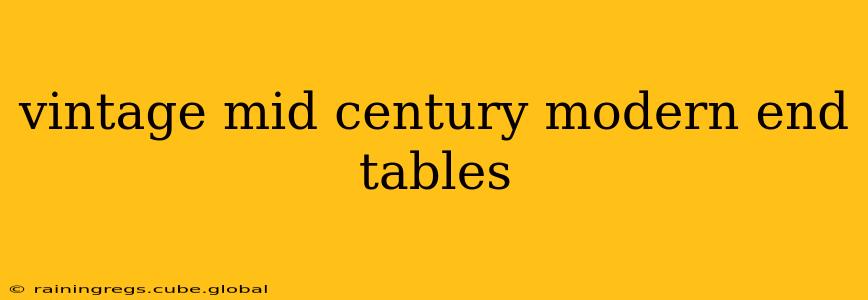The allure of vintage mid-century modern (MCM) furniture is undeniable. Its clean lines, organic shapes, and focus on functionality continue to resonate with today's design sensibilities. End tables, in particular, represent a perfect blend of form and function, adding both style and practicality to any living space. But navigating the world of vintage MCM end tables can be tricky. This guide will help you understand what to look for, what to avoid, and how to find the perfect piece for your home.
What Defines a Mid-Century Modern End Table?
Before diving into the hunt, it's crucial to understand the defining characteristics of MCM design. Generally, MCM end tables exhibit:
- Simple, clean lines: Avoid overly ornate details or fussy embellishments. Think streamlined silhouettes and geometric shapes.
- Organic forms: Often incorporating natural materials and flowing, sculpted shapes inspired by nature.
- Tapered legs: A signature element, frequently featuring splayed or elegantly tapered legs.
- Quality materials: MCM furniture often prioritizes durable materials like solid wood (teak, walnut, rosewood are common), and sometimes metal or glass.
- Functionality: MCM design emphasized practicality. End tables were designed to be useful, not just decorative.
What Wood Types Are Common in Vintage MCM End Tables?
Several wood types were popular during the mid-century modern era. Understanding these can help you identify authentic pieces and appreciate their unique characteristics:
- Teak: Known for its rich brown color, durability, and beautiful grain patterns.
- Walnut: Offers a darker, more sophisticated look with prominent grain.
- Rosewood: Features a reddish-brown hue and often exhibits a striking grain.
- Mahogany: A classic choice prized for its reddish-brown tones and strength.
How Can I Identify Authentic Vintage MCM End Tables?
Authenticity is key when buying vintage furniture. Here's how to spot a genuine MCM piece:
- Examine the construction: Look for joinery techniques like dovetail joints, which indicate high-quality craftsmanship.
- Check the hardware: Original hardware often features simple, understated designs. Replacement hardware might be a sign of restoration or inauthenticity.
- Inspect the materials: Authentic pieces will often use solid wood and high-quality veneers.
- Research the maker: Some manufacturers, like Paul McCobb or Eero Saarinen, are highly sought after. Knowing the maker can significantly increase a piece's value.
What Should I Look for When Buying a Vintage MCM End Table?
Beyond authenticity, consider these factors when making your purchase:
- Condition: Check for scratches, dents, and water damage. Minor imperfections are expected, but major structural issues should be a concern.
- Size and scale: Ensure the end table is appropriately sized for your space and complements your existing furniture.
- Style: Choose a style that aligns with your personal taste and overall decor.
- Price: Research comparable pieces to determine a fair market value.
Where Can I Find Vintage MCM End Tables?
Several avenues exist for finding your perfect MCM end table:
- Antique shops and flea markets: These are treasure troves for vintage finds.
- Online marketplaces: Websites like eBay and Etsy offer a vast selection.
- Consignment shops: Check local consignment stores specializing in vintage furniture.
- Auction houses: You might find rare and high-value pieces at auction.
How Much Do Vintage MCM End Tables Typically Cost?
The price of a vintage MCM end table varies widely depending on the maker, condition, material, and rarity. Expect to pay anywhere from a few hundred dollars to several thousand for highly sought-after pieces.
How Can I Care for My Vintage MCM End Table?
Proper care ensures your end table's longevity and beauty:
- Dust regularly: Use a soft cloth to prevent dust buildup.
- Avoid harsh chemicals: Use gentle cleaners designed for wood furniture.
- Protect from sunlight: Excessive sunlight can fade the finish.
- Use coasters and placemats: Protect the surface from scratches and water rings.
Finding the perfect vintage mid-century modern end table requires research, patience, and a keen eye. By understanding the characteristics of MCM design and following these tips, you'll be well on your way to adding a stylish and functional piece to your home. Remember to always carefully inspect any piece before purchasing to ensure it's a worthwhile addition to your collection.
